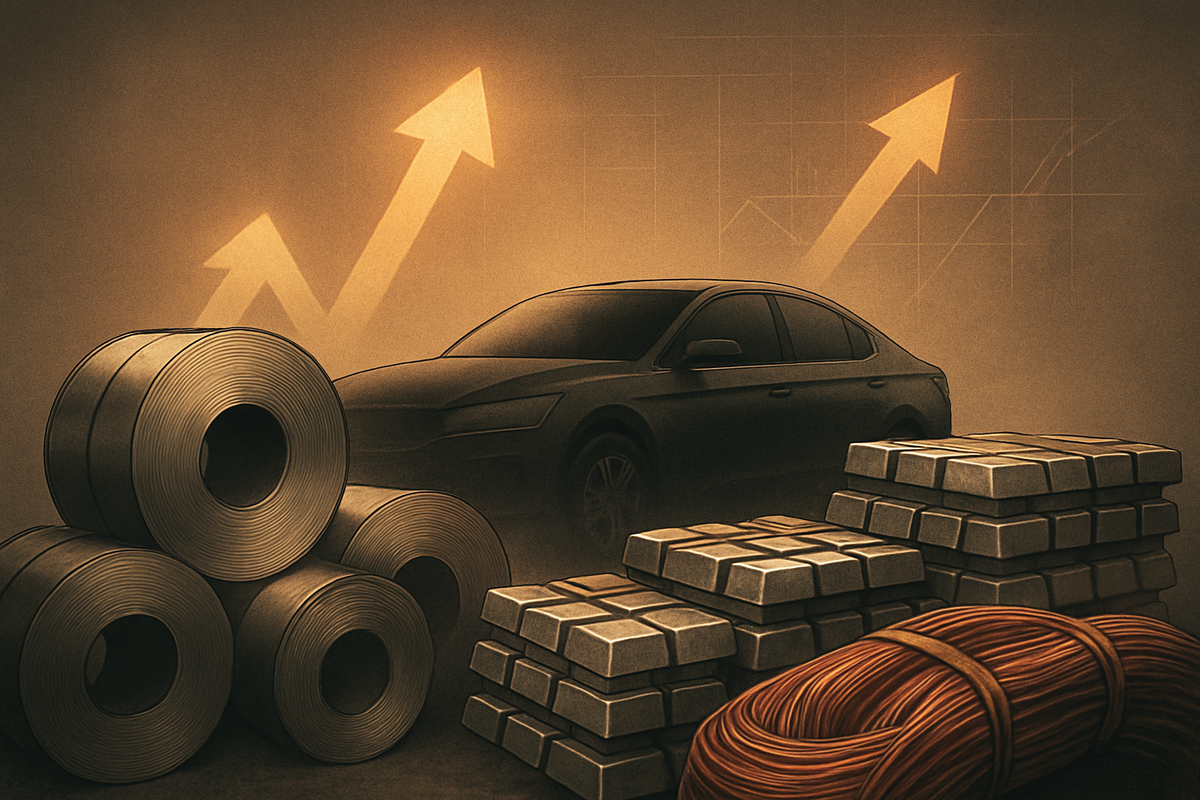Financial News
Tata Motors Navigates Commodity Headwinds: Price Hikes and Strategic Demerger Aim to Safeguard Margins

Mumbai, India – November 25, 2025 – Tata Motors (NSE: TATAMOTORS), India's automotive behemoth, is confronting significant pressure on its profit margins due to persistently rising commodity costs. This challenging environment has necessitated a series of price hikes across its commercial and passenger vehicle segments throughout 2024 and 2025, with further increases anticipated for early 2026. The company's proactive pricing strategy is a crucial move to partially offset the escalating input costs and maintain financial stability amidst a dynamic global and domestic market.
The continuous surge in raw material prices, including steel, aluminum, copper, and precious metals, has directly impacted Tata Motors' operational expenses. These cost pressures, coupled with broader inflationary trends and logistics challenges, have forced the company to pass on a portion of the burden to consumers. This ongoing adjustment in pricing is not an isolated event but a strategic response to protect profitability, ensuring the company's long-term health and investment capacity in future technologies like electric vehicles.
Unpacking the Cost Conundrum and Tata's Strategic Response
The automotive industry's reliance on a diverse array of raw materials makes it particularly vulnerable to commodity market fluctuations. For Tata Motors, the impact has been tangible, directly influencing its profitability and operating margins. Industry estimates suggest that carmakers' input costs have surged by 10-15% within a year, severely squeezing operating margins across the board. The company's Passenger Vehicle (PV) division, for instance, saw its EBIT margin broadly flat at 0.2% in Q2 FY26, a direct consequence of these commodity cost pressures.
In response, Tata Motors has systematically implemented price adjustments across its portfolio. Commercial Vehicles (CVs) saw increases of 3% in January 2024, 2% in April 2024, and up to 2% in July 2024, marking the third hike for CVs that year. Passenger Vehicles (PVs) experienced an average 0.7% hike in February 2024, followed by a significant average 3% increase across its entire PV portfolio, including electric vehicles (EVs), in January 2025. Further hikes of 1% to 4% were implemented in February 2025, and another price increase for all Tata passenger cars (ICE and electric models) was announced for April 2025. The management anticipates further price hikes for PV Internal Combustion Engine (ICE) models, expected to be effective from January 2026. These measures are complemented by internal cost-cutting, value engineering, and vendor negotiations to absorb some of the pressure.
Key stakeholders involved in this situation include Tata Motors' management, raw material suppliers, dealers, and ultimately, customers who bear the brunt of higher prices. Investors and financial analysts closely monitor these developments, scrutinizing earnings reports for signs of margin protection and sustainable growth. The initial market reaction to these price hikes has been varied; while some see it as a necessary step for profitability, concerns linger about potential impacts on consumer demand, especially in price-sensitive segments. Other major automakers like Maruti Suzuki India Ltd. (NSE: MARUTI) and Hyundai Motor India have also implemented similar hikes, indicating an industry-wide response to these pervasive cost pressures.
Winners and Losers: A Shifting Automotive Landscape
The current environment of rising commodity costs and subsequent price hikes creates a complex scenario of potential wins and losses across the automotive ecosystem, with Tata Motors (NSE: TATAMOTORS) at the forefront.
Potential Wins for Tata Motors: The most immediate benefit for Tata Motors is the protection of its profit margins. By passing on increased input costs, the company aims to maintain financial robustness. Its strategic positioning in premium segments, particularly with its strong SUV portfolio (Nexon, Punch), and its leadership in the nascent Indian EV market (holding around 65-73% market share) may allow it to implement price hikes with less significant demand erosion. Furthermore, Tata Motors' proactive cost mitigation strategies, including vendor negotiations, value engineering, and joint ventures for EV components, combined with a focus on exports, contribute to absorbing some of the cost pressure. The recent demerger of its commercial and passenger vehicle businesses, effective October 2025, is also expected to unlock shareholder value and foster more focused growth strategies, potentially leading to improved operational efficiency and agility for each entity.
Potential Losses for Tata Motors: Frequent price increases carry the risk of reduced consumer demand, particularly in the price-sensitive entry-level passenger vehicle and small commercial vehicle segments, as well as rural markets. This could lead to a loss of market share in a highly competitive landscape. Sustaining profitability in affordable segments becomes increasingly challenging, potentially impacting its appeal to first-time buyers. The operational headwinds from continuously hardening commodity prices, if severe and sustained, could still pressure margins despite price adjustments. Moreover, its luxury arm, Jaguar Land Rover (JLR), a key part of the demerged passenger vehicle entity, faces significant vulnerabilities from US tariffs on imported vehicles and components, and weak demand in crucial international markets, which could drag down overall group profitability.
Impact on Competitors and Related Industries:
- Winners: Automakers with strong brand loyalty and premium positioning, such as Mercedes-Benz India (NSE: MERCEDESBENZ) and BMW India (NSE: BMW), may be less susceptible to price elasticity, allowing them to pass on costs more effectively. Companies with robust supply chain management, backward integration, and diversified supplier bases, like Mahindra & Mahindra (NSE: M&M), are better positioned to mitigate cost volatility. Producers of alternative materials or technologies that offer cost reductions could also see increased demand.
- Losers: Automakers heavily reliant on entry-level and mass-market segments with thin margins, like Maruti Suzuki India Ltd. (NSE: MARUTI), face tougher challenges as price hikes risk alienating cost-conscious consumers. Companies with less efficient supply chains, weaker brand loyalty, or slower product innovation will struggle more to pass on cost increases. Automotive component suppliers (e.g., Bosch (NSE: BOSCHLTD)) may also suffer if automakers push to absorb costs from their supply chain, impacting their own profitability. Dealerships and retailers could face difficulties moving inventory at higher price points, potentially impacting their margins.
Broader Implications: A Tectonic Shift in Automotive Dynamics
The persistent rise in commodity costs and the ensuing price hikes by automotive manufacturers like Tata Motors are not isolated incidents but rather integral components of a wider, transformative shift within the global and Indian automotive industries. This phenomenon is deeply intertwined with macroeconomic trends, geopolitical dynamics, and the accelerating transition towards electrification.
Broader Industry Trends and Global Context: The current scenario is a reflection of global supply chain disruptions, inflationary pressures, and geopolitical tensions that have driven up prices for critical raw materials such as steel, aluminum, copper, and precious metals. The global semiconductor chip shortage, while easing in some areas, continues to pose challenges, particularly for mature nodes. The rare earth magnet crisis, stemming from export restrictions, further highlights material scarcity risks, especially for EV components. A depreciating Indian Rupee against the US dollar exacerbates the cost of imported components, while stricter emission norms (like BS-VI Phase 2) necessitate more advanced and often costlier materials and technologies. The accelerated shift towards electric vehicles, while environmentally beneficial, intensifies demand for battery materials, making their prices highly sensitive. India, as the world's third-largest auto market, is a significant player in these global dynamics, with its domestic OEMs showing resilience but still grappling with hardening commodity prices.
Ripple Effects and Regulatory Landscape: These cost pressures create a cascading effect throughout the automotive value chain. Beyond OEMs, auto component suppliers face direct exposure to raw material volatility, potentially impacting their profitability and order volumes. Consumers are directly affected by higher vehicle prices, which can lead to delayed purchases or a shift towards used vehicles, particularly impacting rural buyers. Governments and regulatory bodies are actively involved, offering incentives and subsidies (like India's Production-Linked Incentive (PLI) schemes for auto and EV) to promote local manufacturing and reduce import dependency. Trade policies, such as US tariffs on auto components and potential safeguard duties on steel imports, directly influence material costs and supply chain strategies. The emphasis on "Atma Nirbhar Bharat" (self-reliant India) aims to build resilience against global supply shocks by encouraging domestic sourcing.
Historical Precedents: The current situation echoes past periods of economic volatility and supply chain disruptions. The COVID-19 pandemic starkly exposed vulnerabilities in "Just-In-Time" manufacturing, leading to widespread production losses. Past semiconductor shortages and commodity price spikes (e.g., steel price increases in 2008) serve as historical precedents, demonstrating the industry's recurring challenges and its learned responses through price adjustments and cost-cutting measures. Geopolitical events, such as the US sanctions against Rusal impacting aluminum prices in 2018, also highlight how global politics directly influence raw material availability and cost.
The Road Ahead: Navigating Uncertainty and Embracing Transformation
As of late 2025, the automotive industry, and Tata Motors (NSE: TATAMOTORS) in particular, stands at a critical juncture, with short-term challenges and long-term transformative possibilities shaping its trajectory.
Short-Term (Late 2025 - 2026): The immediate future will likely see continued price adjustments across the industry, with a projected 2-8% surge in passenger vehicle prices in 2026. Semiconductor shortages, particularly for mature nodes, are expected to persist, further impacting production. Consumer price sensitivity remains a significant concern, with potential for reduced demand if price hikes are not carefully managed. The focus for automakers will be on strengthening supply chain resilience through diversified sourcing and localization. While global demand might remain subdued, a gradual recovery in the domestic Indian market is anticipated, driven by new product launches and festive seasons, though tempered by a slowing economy and high borrowing costs.
Long-Term (Beyond 2026): The long-term outlook holds promise, especially for electric vehicles. While overall vehicle prices may rise, EV prices could see a nuanced trend, potentially decreasing by 3-8% in 2026 due to declining battery costs and fierce competition, bringing them closer to parity with ICE vehicles. This could accelerate EV adoption. The automotive semiconductor market is projected for significant growth, driven by EVs and ADAS. The industry will increasingly focus on sustainable and lightweight materials, with an emphasis on recycled content and lower carbon footprints. Supply chain restructuring, including nearshoring and reshoring, will be a sustained effort to reduce import dependence. Macroeconomic stimulus in India, such as potential income-tax rate reductions and interest rate cuts, could further fuel demand recovery.
Strategic Pivots and Adaptations: Tata Motors and its peers will need to implement several strategic pivots. Enhanced supply chain resilience through greater visibility, geographic diversification, and direct sourcing of critical components like semiconductors and rare earths will be paramount. Aggressive cost management, including lean manufacturing, value engineering, vendor negotiations, and commodity hedging, will be crucial. Material innovation, with a focus on lightweighting and circular economy principles, will drive both cost efficiency and sustainability. Finally, flexible pricing strategies, calibrated hikes, range simplification, and attractive financing schemes will be necessary to balance profitability with maintaining market share and consumer affordability.
Wrap-up: A Test of Resilience and Strategic Acumen
The journey through 2024 and 2025 has been a testament to the automotive industry's, and particularly Tata Motors' (NSE: TATAMOTORS), resilience in the face of unprecedented commodity cost pressures. The strategic implementation of price hikes, while challenging for consumers, has been a critical mechanism to safeguard profit margins and ensure financial stability. The recent demerger of Tata Motors' commercial and passenger vehicle businesses, effective October 2025, further underscores a bold move to create more agile and focused entities, poised to unlock greater shareholder value.
Key Takeaways: Persistent commodity inflation has necessitated widespread price increases across the automotive sector. Tata Motors has been at the forefront of this trend, strategically adjusting prices to protect its bottom line. The demerger is a significant structural change aimed at enhancing operational efficiency and strategic focus. However, the performance of Jaguar Land Rover (JLR), especially in the wake of a Q2 FY26 cyberattack and weak international demand, remains a key variable influencing the overall profitability of the newly formed passenger vehicle entity.
Market Moving Forward: The market will continue to grapple with commodity price volatility and consumer price sensitivity. While the Indian domestic market shows signs of recovery, global demand remains muted, impacting international operations like JLR. The accelerating shift to electric vehicles presents both opportunities and challenges, with declining battery costs potentially boosting EV adoption, but overall input costs still influencing final vehicle prices.
Significance and Lasting Impact: The current period marks a significant recalibration for the automotive industry, emphasizing the need for robust supply chain management, aggressive cost control, and strategic flexibility. For Tata Motors, its ability to effectively navigate these headwinds, leverage its leadership in the Indian EV market, and successfully integrate the benefits of its demerger will determine its long-term growth trajectory and competitive standing. The enduring impact will be a more resilient, localized, and potentially more sustainable automotive ecosystem.
What Investors Should Watch For: Investors should closely monitor global commodity price trends, particularly for steel, aluminum, and battery raw materials. The market acceptance of Tata Motors' recent and upcoming price hikes, reflected in sales volumes and market share, will be crucial. A keen eye should be kept on JLR's operational recovery, margin restoration, and demand trends in key markets. The independent financial performance and strategic announcements of both the demerged commercial vehicle and passenger vehicle entities will provide insights into their individual growth paths. Finally, progress in Tata Motors' EV expansion, competition in this segment, and the company's journey towards becoming net automotive debt-free will be vital indicators of its future health.
This content is intended for informational purposes only and is not financial advice
More News
View More




Recent Quotes
View More
Quotes delayed at least 20 minutes.
By accessing this page, you agree to the Privacy Policy and Terms Of Service.



